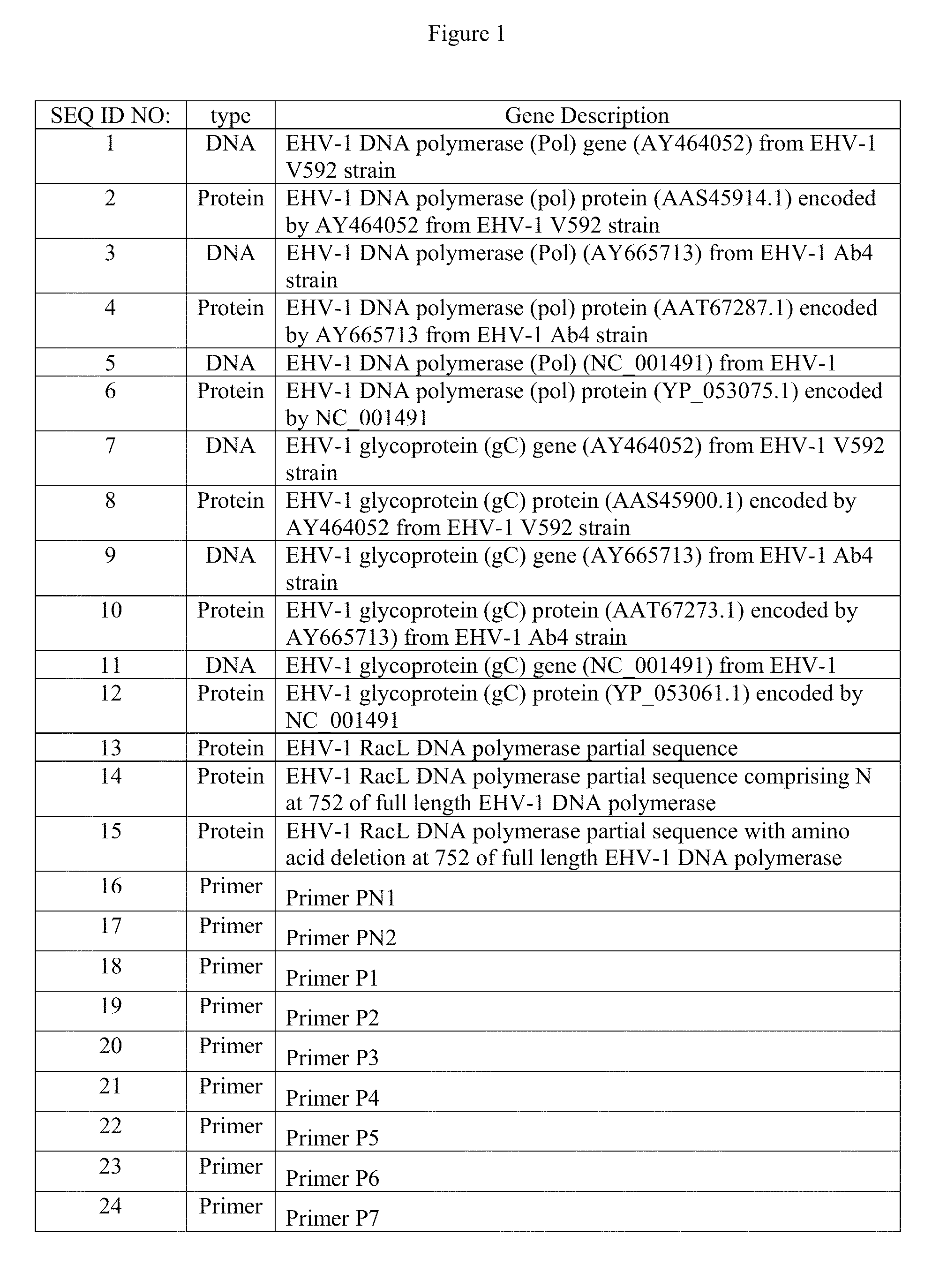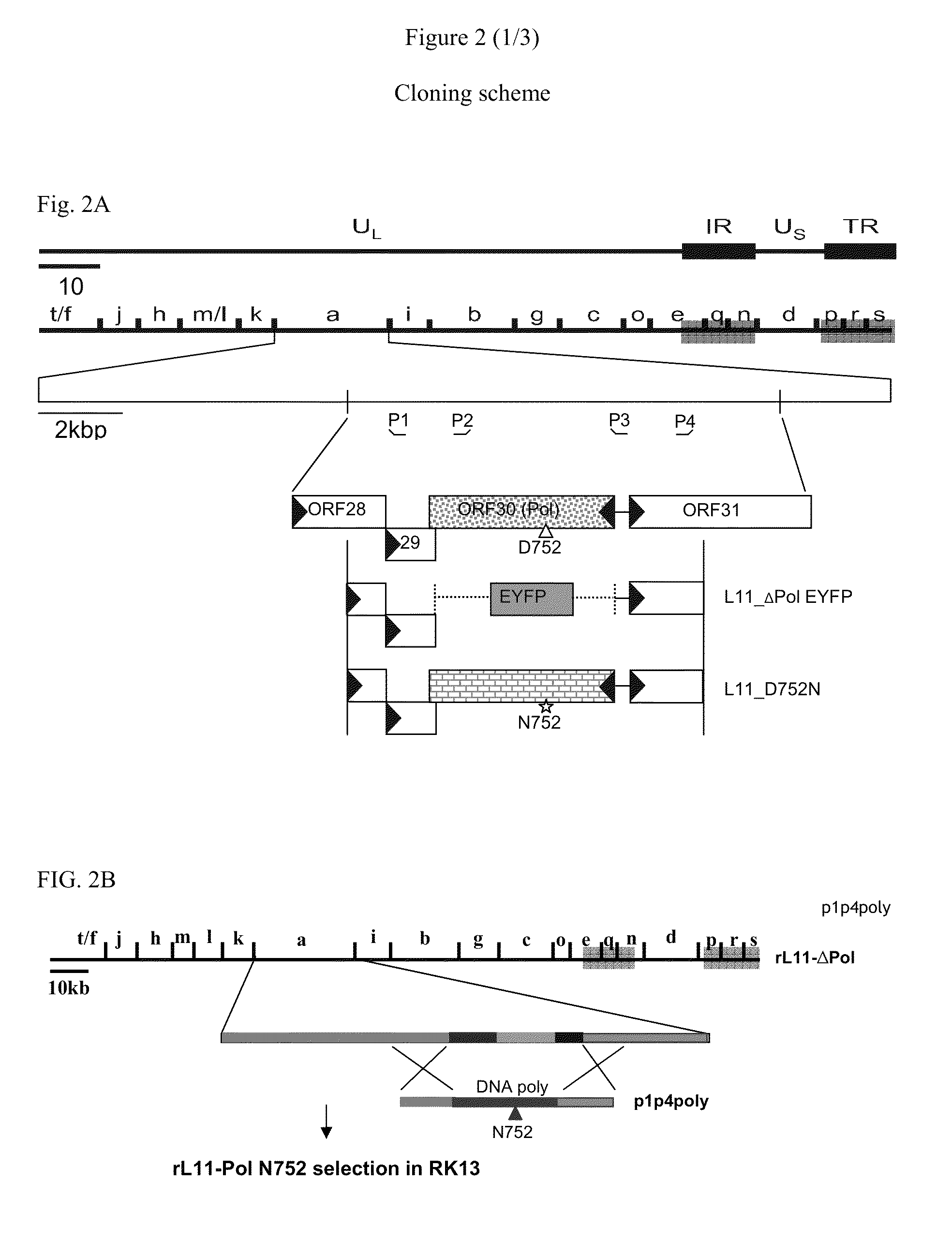Recombinant equine herpesvirus-1 vaccine containing mutated glycoprotein C and uses thereof
a technology of equine herpesvirus and glycoprotein, which is applied in the field of equine herpesvirus-1 vaccines containing mutated glycoproteins, can solve the problems of inability to prevent cell-associated viremia, inability to prevent ehv-1 or disease state(s) caused, and complex pathogenesis of ehv infection
- Summary
- Abstract
- Description
- Claims
- Application Information
AI Technical Summary
Benefits of technology
Problems solved by technology
Method used
Image
Examples
example 1
Construction of Cell Line RK13_Pol
Cells and Viruses
[0111]Rabbit kidney (RK13) cell was maintained in Earle's minimum essential medium (EMEM) supplemented with 10% heat-inactivated fetal bovine serum (FBS), 100 U / ml penicillin and 0.1 mg / ml streptomycin (1% Pen / Strep). Equine skin fibroblast cell line (NBL6) was maintained in EMEM supplemented with 10% FBS, 29 mg / ml L-glutamate, 1% Pen / Strep and 1% nonessential amino acids (Gibco BRL). EHV-1 strains RacL11 and NY03 were grown on fresh RK13 cells. NY03, harboring a non-neurological form of DNA polymerase (N752 Pol), was isolated from an aborted foal from a farm in New York in 2003.
Construction of Cell Line RK13_Pol
[0112]To support the growth of Pol-negative RacL11 mutant, a rabbit kidney cell line designated RK13_Pol expressing the non-neurological form of the polymerase (N752) was first generated. The whole polymerase open reading frame of NY03 was amplified from viral genomic DNA, which was extracted from virus infected RK13 cells. ...
example 2
Plasmids and Viral Mutagenesis
Generation of Virus Mutants
[0114]Conventional homologous recombination strategy was employed for all genetic manipulations. Two 1.7 kbp flanking fragments on either side of DNA polymerase were amplified using thermostable Pfu polymerase (Promega) and primer pairs P1 / P2 and P3 / P4 from RacL11 genome. Another two primer pairs P5 / P6 and P7 / P8 were used to amplify the HCMV (human cytomegalovirus) promoter and EYFP (enhanced yellow fluorescent protein) gene from plasmid pEYFP-N1, separately. The 5′ ends of primers P2 and P5, P3 and P8 as well as P6 and P7 carry homologous sequences of 21-23 bp. With an overlapping PCR using P5 and P8, HCMV promoter and EYFP gene were fused and cloned into plasmid pCR2.1-Topo (Invitrogen) resulting in pCES1. For the construction of shuttle plasmid pCR-Topo-P1P4, the above two homolog arms and EYFP expressing cassette in pCES1 were combined by overlapping PCR using primers P1 / P4 and cloned into pCR2.1-Topo. Using pCES1 as templ...
example 3
Characterization of In Vitro Virus Growth
[0121]Virus attachment assay was carried out as described in Sun et al. (J Gen Virol 77, 493-500, 1996) with slight modifications. Monolayers of RK13 cells seeded in 6-well plates were cooled for 1 h at 4° C. and infected with RacL11, L11_D752N, L11_D752N ΔgC or L11_D752N ΔgC rev with an MOI of 400 plaque-forming units (PFU) per well. The viruses were left to attach for various length of time (0, 15, 30, 60, 120, 240 min) at 4° C. At various time points, infected cells were washed three times with PBS and overlaid with EMEM containing 2% FBS and 1.5% methylcellulose. After incubation for 3 days at 37° C., cells were fixed with 10% formaldehyde and stained with 0.3% crystal violet. Plaques were counted and the percentage of virus attachment at each time point was calculated, relative to time point 240 min that was set to 100% attachment.
Plaque Size and Single-Step Growth Kinetics
[0122]To compare the plaque sizes, RK13 cel...
PUM
| Property | Measurement | Unit |
|---|---|---|
| pH | aaaaa | aaaaa |
| concentration | aaaaa | aaaaa |
| volume | aaaaa | aaaaa |
Abstract
Description
Claims
Application Information
 Login to View More
Login to View More - R&D
- Intellectual Property
- Life Sciences
- Materials
- Tech Scout
- Unparalleled Data Quality
- Higher Quality Content
- 60% Fewer Hallucinations
Browse by: Latest US Patents, China's latest patents, Technical Efficacy Thesaurus, Application Domain, Technology Topic, Popular Technical Reports.
© 2025 PatSnap. All rights reserved.Legal|Privacy policy|Modern Slavery Act Transparency Statement|Sitemap|About US| Contact US: help@patsnap.com



